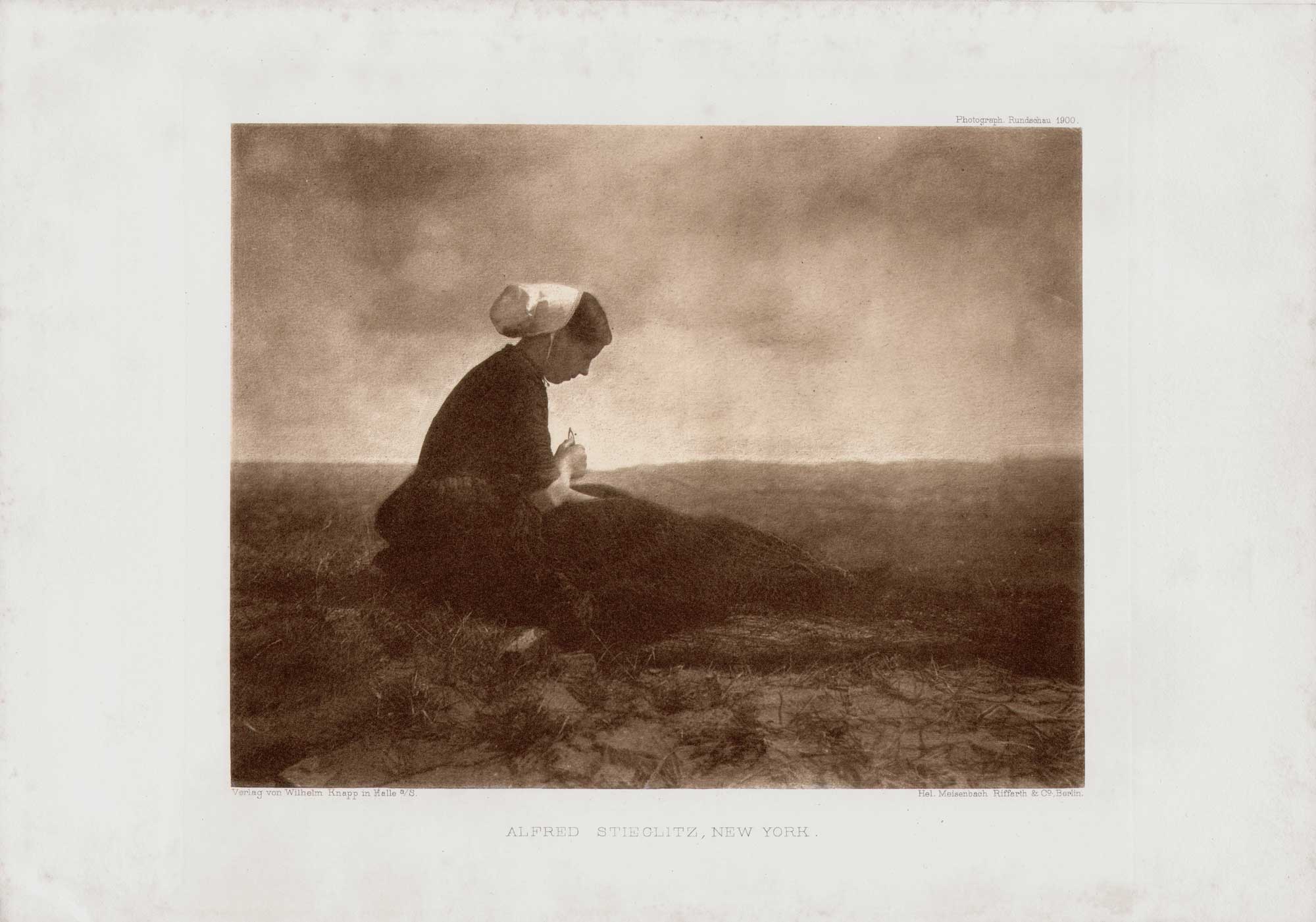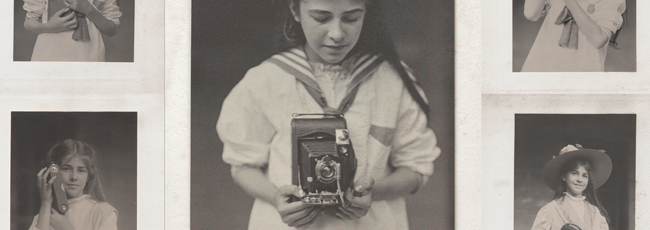
“The Net Mender” by American photographer Alfred Stieglitz, was published as a hand-pulled photogravure in the December, 1900 issue of the Photographische Rundschau.
The German photographic journal Photographische Rundschau (Photographic Review) was one of:
“the earliest magazines specifically produced for amateurs, for non-specialists in both art and science.” 1.
For the purpose of a historical record relating to artistic photography, it is an important document of its progress:
“The main reason to subscribe to this magazine, at least after 1894, was its perfect illustration with photographs from masters of the art.” 2.
From 1896-1902, the most important promoter of artistic photography within its pages was due to its German picture editor-Ernst Juhl, who actively promoted the work of amateur photographers and pictorialism on an international level. Juhl was forced to resign from the journal in 1902 after making the decision to publish the progressive and decidedly unconventional work of American photographer Eduard Steichen (then working in Paris) in its pages.
Issued monthly, (bi-monthly beginning in 1903) the magazine typically published one hand-pulled photogravure supplemental plate with each issue as well as other full-page illustrations in halftone.
1887 was the first year Photographische Rundschau was published, but not in Germany. It began life as the official organ of the Club der Amateur Photographen in Wien, (Club of Amateur Photographers in Vienna) and was published and edited by Charles Scolik. One year later:
“in 1888 it found a publisher in Halle an der Saale in Germany. Wilhelm Knapp was an important scientific publisher whose brother Carl was directly interested in photography. So for five years the journal was written in Vienna by Club members, published in Halle an der Saale, and distributed in Germany and Austria.” 3.
1893 proved to be the transformative year for the journal:
“But in August 1893, for unknown reasons, almost certainly at the publisher’s instigation, the journal grew another head when Richard Neuhauss in Berlin began sharing the role of editor-in-chief with Charles Scolik in Vienna.” 4.
The loss of direct editorial control from Vienna to Berlin for the journal was also cemented with the establishment of a new journal for the Vienna club, the Wiener Photographische Blätter.
By the following year, 1894, Dr. Richard Neuhauss appeared solely as the journal’s editor on the title page. Approximately 680 kilometers (425 miles) separates Berlin with Vienna, but philosophically, in relation to amateur photography as a social construct for the period, the distance was greater. Speaking of this divide, contemporary author Christian Joschke remarks:
“The photographers of the two capitals did not share the same vision of amateurism. For the Viennese members of the Club der Amateur Photographen, this socialized aspect of leisure photography was a way of legitimizing its artistic character.” 5.
And the view from Berlin:
“But for the Berlin groups this separation gave photography too confined a role. They needed to build a shared culture, mixing science with art and transcending the divisions between the two domains. For them the network of amateurs offered the possibility of building a shared culture of images, fostered by the popularization of science and consolidated by a practice that paid attention to “advances” in every domain.” 6.
The growing popularization of science in Germany, of which amateur photography was central, found the perfect editor in Richard Neuhauss. Indeed, one of the first things he changed was its tone on the title page of the journal. He added “Zeitschrift für Freunde der Photographie” (Magazine for Lovers of Photography) at the tail-end of Photographische Rundschau’s title, replacing the simple “Monats-Zeitschrift für Photographie” (Monthly journal of photography) that formerly appeared. A polymath with interests including amateur photography, photographic chemistry, anthropology (he was a member of the Society for Anthropology, Ethnology and Prehistory) and even aviation, Dr. Richard Neuhauss (1855-1915):
“was a doctor of tropical medicine who resided in Berlin but traveled widely. He published on many medical subjects but also was a superb experimentalist in photography with a special affinity for the Lippmann Process.” (early French color process) 7.
Unique insights into his curiosity and scientific ambitions came into play in 1895, the year he put his skills to work building specialized cameras for the purpose of photographically documenting flight. A remarkable series of his photographs recording biplane and “Vorflügelapparat” (glider with wing tip controller) flights of German aviation pioneer Otto Lilienthal at the “Flying-Hill” in Lichterfelde Germany are now preserved in a museum bearing Lilienthal’s name in Anklam Germany. 8.
Neuhauss continued as editor of the journal until 1907, when he left and was replaced in 1908 by a group of three editors: Dr. Richard Luther, art photography advocate, photographer and painter Fritz Matthies-Masuren and Otto Mente. Of Luther and Mente, contemporary writer Rolf Sachsse comments:
“…both were lecturers in photo-chemistry and gave the magazine a more scientific note.” 9.
Merging with other photographic journals also caused Photographische Rundschau to change names several times until it finally ceased publication under the Rundschau moniker in 1943. Beginning in 1904 and lasting until 1911, it joined forces with publisher Wilhelm Knapps Photographisches Centralblatt, (Photographic Journal ) becoming the Photographische Rundschau und Photographisches Centralblatt. From 1912 until 1933, it combined with the former Photographische Mitteilungen to become the Photographische Rundschau und Mitteilungen, and from 1934-1943 its name changed to the Fotografische Rundschau.
Beginning in 1904, the year it combined forces with the Photographisches Centralblatt, the quality of the supplemental photographic plates also changed in Photographische Rundschau . Hand-pulled photogravures produced by some of Germany and Austria’s finest ateliers now included full-page, sheet fed gravures produced by mechanical (machine) presses. Close magnification of these plates reveals an extremely fine screen pattern. Plate marks-a good indicator of a hand-pulled photogravure (although faux plate-marks are sometimes added as a decorative element to other types of process photographs) are absent from the borders of these screen-photogravure plates.
With only several exceptions as noted, our online galleries include all photogravure supplements for this journal as well as additional photographic plates from Photographische Rundschau’s most significant achievement in relation to artistic photography: 1894-1908.
NOTES:
1. PHOTOGRAPHISCHE RUNDSCHAU: ROLF SACHSSE: IN: ENCYCLOPEDIA OF NINETEENTH-CENTURY PHOTOGRAPHY, VOLUME 1: EDITED BY JOHN HANNAVY: ROUTLEDGE-TAYLOR & FRANCIS GROUP: NEW YORK: 2007: P. 1096
2. IBID
3. AMATEURISM AND CULTURAL CHANGE-PHOTOGRAPHY IN GERMANY AND AUSTRIA (1880-1900): CHRISTIAN JOSCHKE: IN: IMPRESSIONIST CAMERA: PICTORIAL PHOTOGRAPHY IN EUROPE, 1888-1918 : MERRELL PUBLISHERS : 2006 : P.109
4. IBID
5. IBID: P. 110
6. IBID
7. NEUHAUSS BIOGRAPHY: IN: ENCYCLOPEDIA OF NINETEENTH-CENTURY PHOTOGRAPHY, VOLUME 1: EDITED BY JOHN HANNAVY: ROUTLEDGE-TAYLOR & FRANCIS GROUP: NEW YORK: 2007: P. 990
8. NEUHAUSS ONLINE ARCHIVE: OTTO LILIENTHAL MUSEUM: ANKLAM GERMANY
9. PHOTOGRAPHISCHE RUNDSCHAU: ROLF SACHSSE: IN: ENCYCLOPEDIA OF NINETEENTH-CENTURY PHOTOGRAPHY, VOLUME 1: EDITED BY JOHN HANNAVY: ROUTLEDGE-TAYLOR & FRANCIS GROUP: NEW YORK: 2007: P. 1096

















